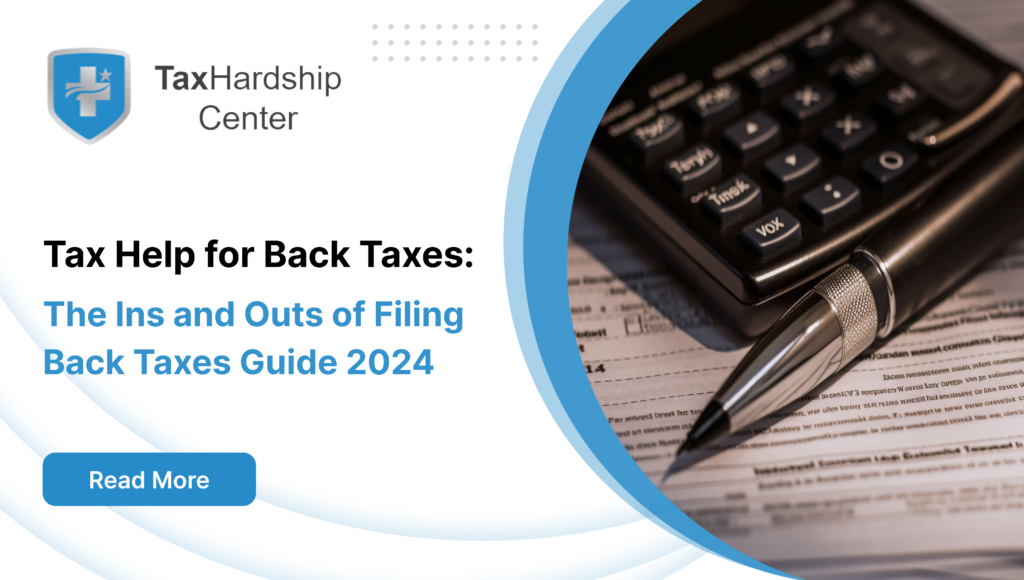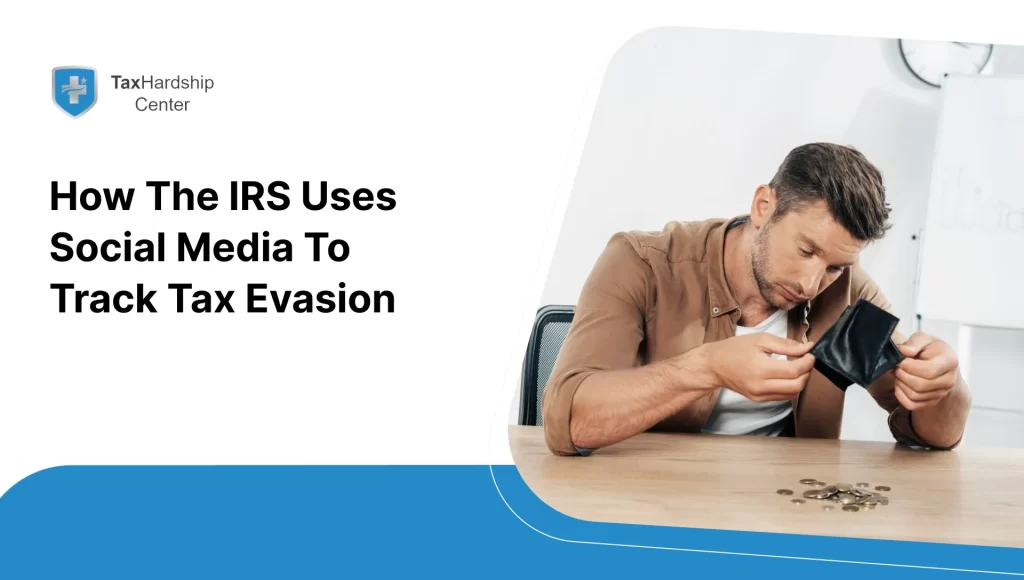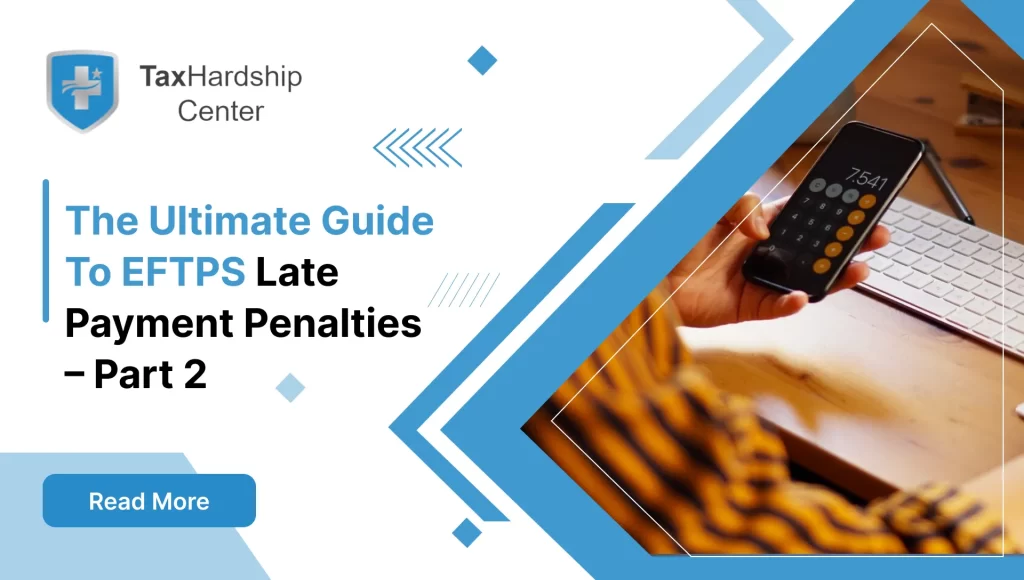Dealing with back taxes can be daunting, but understanding your situation and the options available for tax help can make the process smoother and less stressful. Whether you’re a seasoned taxpayer or this is your first encounter with IRS difficulties, this guide will shed light on the essentials of handling back taxes.
What are Back Taxes?
Back taxes refer to any unpaid taxes from previous years. They can accumulate due to overlooked filing, financial hardships, or forgetting to pay the required amount. Back taxes can lead to severe economic and legal ramifications if not addressed promptly.
How Tax Hardship Center Helps With Back Taxes
The Tax Hardship Center specializes in providing personalized assistance to individuals struggling with back taxes. Our team of experts evaluates each case to develop customized strategies, including negotiating payment plans, reducing tax liabilities, and even representing clients before the IRS. By leveraging our expertise and understanding of tax laws, we aim to ease the burden of tax debt and offer a pathway toward financial stability. Schedule a free consultation now.
How to Deal With Back Taxes and Unfiled Tax Returns with the IRS
Dealing with the IRS over back taxes and unfiled tax returns can feel overwhelming, but taking decisive action can help you regain control of your financial situation. Here is an expanded approach to addressing these tax issues, which could lead you toward a fresh start.
1. File Your Tax Returns
The critical first step in resolving tax debt is to ensure you file all overdue tax returns. Keeping yourself updated with your filing obligations reduces the chance of additional penalties and provides a clear picture of your tax liability. Utilizing user-friendly tax software can simplify this process, or you may prefer the guidance of a tax professional who can help you navigate complex tax scenarios and maximize any potential refunds.
If tax refunds are due, they can be applied to your overall tax debt, directly reducing the amount you owe. It’s integral to file as soon as possible, as the IRS imposes a statute of limitations on refund claims, typically allowing you to claim refunds only within three years of the original due date of the tax return.
2. Pick a Payment Plan
After your tax returns are accurately filed and your tax debt is established, the next step is to work out a payment arrangement with the IRS. This can make your financial obligations more manageable and prevent further collection actions. Here are the primary options offered:
Installment Agreement
An installment agreement is one of the most common tax relief options for taxpayers to manage their tax debt. With this plan, you agree to pay the total taxes owed, plus any interest and penalties, through monthly payments. There are several installment agreements, and the terms can vary based on the amount of debt and your ability to pay. Setting up an installment agreement may require financial disclosure to the IRS, but it can be done online for smaller tax debts.
Offer in Compromise
An Offer in Compromise (OIC) program allows qualified individuals to negotiate a settlement with the IRS that is less than the total taxes owed. This option is only for some; it’s specifically designed for those who can demonstrate that paying the total amount would create financial hardship. The IRS considers your income, expenses, asset equity, and ability to pay before granting an OIC. It’s a potentially beneficial option, but the process is complex, and the criteria are stringent. You’re advised to seek the services of a tax professional or a tax relief company to navigate an OIC.
Currently Not Collectible
For taxpayers experiencing extreme financial hardship, the IRS may declare their tax liability as Currently Not Collectible (CNC). Under this status, the IRS temporarily halts collection actions. To qualify, you must submit proof of your financial status, showing that any collection would impinge on your basic living expenses. However, interest and penalties continue to accrue, and the IRS will periodically review your income status to determine if you remain eligible for CNC status.
3. Follow the Payment Plan Accordingly
Adherence to the arranged terms is imperative once you’ve secured an installment agreement or any other IRS payment plan. Missing payments can lead to default, which might reactivate collection efforts and negate the agreement’s benefits. Staying current with your payments avoids the accrual of further penalties and interest and demonstrates your commitment to resolving your tax debt. A consistent payment record can also provide positive leverage should you need to renegotiate the terms of your agreement due to a change in financial circumstances.
Consequences of Not Filing Back Taxes
Refrain from addressing back taxes is a serious issue that can result in severe consequences. The Internal Revenue Service (IRS) possesses formidable authority to take action against individuals who fail to file their tax returns and pay the taxes they owe. Taxpayers must understand the possible repercussions and enforceable measures the IRS can employ to collect back taxes. Here is an expanded look at what could happen if one ignores their obligation to file back taxes.
Immediate Financial Penalties and Interest
When you miss a deadline for filing a tax return or paying taxes, the IRS will begin assessing penalties and interest on the unpaid amount. These can accumulate quickly and significantly increase the total amount owed. The failure-to-file penalty is generally more costly than the failure-to-pay penalty, so it’s in your best interest to file your tax return as soon as possible, even if you cannot pay your tax debt immediately.
Wage Garnishment
One action the IRS may take is to garnish your wages. This is a legal process whereby the IRS contacts your employer and requires them to directly send a portion of your wages to the IRS to cover your unpaid taxes. This can continue until your entire tax debt is paid off or other arrangements are made to settle the debt. Wage garnishment can substantially affect your income and make it difficult to manage your regular expenses.
Federal Tax Liens
A federal tax lien is a legal claim against your property, including real estate, personal property, and financial assets, when you neglect or fail to pay a tax debt. A lien protects the government’s interest in all your property, including those acquired after the lien is filed. The existence of a federal tax lien may adversely affect your credit score, making it challenging to get a mortgage, sell property, or access other forms of credit.
Bank Levies
The IRS can also impose a bank levy, which allows it to take money from your bank account. The IRS will notify you and your bank that funds from your account will be seized to satisfy the tax debt. Once a levy is in place, it can be challenging to remove it, and it may leave you with insufficient funds to cover your basic living expenses.
Property Seizure
In extreme cases where significant tax debts remain unpaid and other collection actions have been unsuccessful, the IRS can seize assets—such as cars, boats, or even houses—and sell them to recover the amount owed. The prospect of property seizure is terrifying, as it can deprive you of your most valuable possessions and leave you in a challenging financial situation.
Criminal Charges
In the most egregious cases of tax evasion or fraud, the IRS may pursue criminal charges against the taxpayer, which can result in fines and imprisonment. While these cases are not as common as the civil actions listed above, they represent the most severe consequence of ignoring the IRS’s attempts to collect back taxes.
How Many Years Later Can You File Back Taxes?
Addressing back taxes is an essential financial obligation that taxpayers must approach with attention and urgency. One of the common questions posed by taxpayers facing overdue tax responsibilities is: How many years later can you file back taxes?
The standard period during which the Internal Revenue Service (IRS) typically encourages individuals to file back taxes is within the last six years. The IRS considers this timeframe the period of enforcement for assessing and collecting taxes. However, taxpayers should be aware that in some instances, the IRS may require tax returns going back further than six years, especially if substantial income was not reported or there is evidence of tax evasion or fraud.
Statute of Limitations on Tax Returns and Collections
The statute of limitations is critical in determining how late one can file. For assessing additional taxes, the IRS generally has three years from when you filed your return to question and adjust the reported amounts. If you fail to file a return, this three-year statute never begins, theoretically allowing the IRS to return indefinitely to collect taxes for those unfiled years.
In the case of collecting a tax debt, the IRS has ten years from the date of assessment to pursue collections. The assessment date is typically close to the date you filed your return. If you have yet to file, the evaluation can’t occur, and the ten years for collections doesn’t start, leaving your tax debt in limbo.
Filing Back Taxes
Taxpayers need to understand that even though the IRS usually focuses on the past six years for enforcement, filing all unfiled returns, regardless of how late they are, is the best practice. This is because you, as the taxpayer, are responsible for proving that you have filed returns and paid any taxes due. If the IRS claims you have not filed for a specific year and have no record to prove otherwise, they may go beyond the six-year enforcement policy.
Furthermore, if you’re due a refund for any of the past three years, it’s crucial to file those returns as soon as possible. The IRS typically has a three-year statute of limitations for issuing refunds, meaning that after this period, you forfeit your right to any refunds that may have been owed to you.
In certain situations, taxpayers may have reasons for filing back tax returns beyond what is routinely required. These reasons can include:
- Claiming refunds within the allowable three-year window.
- Lenders may request tax returns from the past several years to fulfill loan application requirements.
- Settling any potential legal disputes where past returns may become relevant.
- Establishing Social Security benefits may depend on earnings and tax records.
Conclusion:
Navigating the complexities of back taxes and unfiled tax returns demands diligence and understanding, but it’s a crucial step toward financial stability. This comprehensive guide has illuminated the path to addressing back taxes effectively, offering insights from filing overdue tax returns to negotiating payment plans with the IRS. By taking proactive measures and exploring available options, individuals can seize control of their tax situations and embark on a journey toward a brighter financial future.
Whether facing immediate penalties, contemplating payment arrangements, or seeking relief from tax debt, prompt action, and professional guidance can make all the difference. With determination and the right approach, individuals can overcome back tax challenges and stride confidently toward financial well-being.
Why Tax Hardship Center?
1. Hassle-Free Assistance:
Say goodbye to sleepless nights and endless tax-related stress. At the Tax Hardship Center, we believe in simplifying the complex. Our team of experts is dedicated to guiding you through every step of the process, ensuring that your tax concerns are met with precision and care.
2. 14-Day Money Back Guarantee:
We’re so confident in our ability to ease your tax worries that we offer a 14-day money-back guarantee. If, for any reason, you’re not satisfied with our service, we’ll gladly refund your investment. Your peace of mind is our top priority!
3. Free Consultation:
Are you curious about how we can transform your tax experience? Book a free consultation now! Our team will assess your situation, answer your questions, and provide free insights tailored to your needs.
4. Nationwide Coverage:
No matter which corner of the United States you call home, the Tax Hardship Center covers you. We proudly serve all 50 states, bringing our expertise to your doorstep. Wherever you are, our commitment to excellence follows.
FAQs:
1. How many years later can you file back taxes?
The IRS typically encourages individuals to file back taxes within the last six years. However, in some instances, returns may need to be filed for periods further back, especially if there’s evidence of tax evasion or substantial unreported income.
2. What are the consequences of not filing back taxes?
Neglecting to address back taxes can lead to severe consequences, including immediate financial penalties, wage garnishment, federal tax liens, bank levies, property seizure, and, in extreme cases, criminal charges for tax evasion or fraud.
3. What options are available for resolving tax debt with the IRS?
Taxpayers can explore various options for resolving tax debt, including installment agreements, offers in compromise (OIC), and currently not collectible (CNC) status. Each option is tailored to specific financial circumstances and eligibility criteria.
4. What is the statute of limitations on tax returns and collections?
The IRS generally has three years from the return filing date to assess additional taxes, while collections have a ten-year statute from the assessment date. However, failure to file indefinitely extends these limits.
5. Why is it essential to file all unfiled tax returns, regardless of how late they are?
Filing all unfiled tax returns is crucial to avoid penalties and prove compliance. It’s also necessary to claim refunds, fulfill loan application requirements, resolve legal disputes, and establish eligibility for Social Security benefits based on earnings and tax records.








